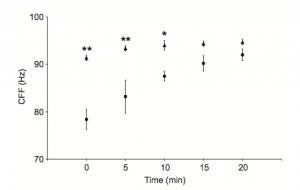
Estimated change in sea water pH caused by human-emitted CO2 between the 1700s and the 1990s (Global Ocean Data Analysis Project (GLODAP) & the World Ocean Atlas)
The widespread consequences of human activity are both remarkable and startling. Nearly 30 to 40% of human-emitted carbon dioxide (CO2) in the atmosphere dissolves into our oceans, leading to a steady increase in ocean acidification that is projected to increase significantly into the future.
Yet ocean acidification, the process of decreasing pH and therefore increasing ocean acidity, is just one of the results of decades of substantial human-caused air pollution. In fact, the rising amount of CO2 in our atmosphere and oceans has a largely unknown consequence for marine life. A recent study suggests that increased CO2 may cause some fish to struggle with the sight of fast-moving elements in their environment. While previous research has illustrated that ocean acidification can negatively impact a fish’s smell and hearing senses, less is known about its impacts on fish sight.

The spiny damselfish, Acanthochromis polyacanthus
To investigate the effects of ocean acidification on fish vision, researchers turned to the spiny damselfish, Acanthochromis polyanthus, largely present in Australia’s Great Barrier Reef and easy to breed in a laboratory setting. The spiny damselfish uses its eyes to detect rapid flickering light, similar to the flickering humans can see on computer or television screens. Therefore, the quality of fish vision can be determined by how well fish interpret various speeds of flickering light.
Researchers exposed fish to different levels of CO2 and used electrodes to detect nerve activity within the eye. If the electrodes detect activity coincidentally with flashing light, it can be assumed that the fish recognize the flickers. However, each fish has a flicker threshold, where flickering light becomes too fast for the fish to process. When introduced to high levels of CO2, this threshold decreases and the fish are unable to recognize quick flickering light.
The results from this study reveal that damselfish exposed to high levels of CO2 have lower flicker thresholds than damselfish exposed to lower levels of CO2. This phenomenon is most likely caused by essential sight and behavior neuron proteins in the eye that are altered by increased CO2.

The low critical flicker fusion (CFF) threshold in high-CO2 treated fish (squares) is restored over 15 to 20 minutes after receptor blocker treatment. Fish treated with low-CO2 (triangles) have consistently higher CFF thresholds.
However, all is not lost for the fish affected by high levels CO2 in this experiment; CO2-induced low flicker thresholds are reversible. Fish exposed to high levels of CO2 were treated with a GABA receptor blocker that restores normal neuronal activity and were able to regain their regular flicker threshold just fifteen minutes after being treated. But while the GABA receptor blocker injections may work to cure fish in a laboratory setting, it would be costly and impractical to treat fish in the wild.
Though the spiny damselfish is just one of thousands of fish species that use this particular family of nerve cell protein, many other fish species also rely on these proteins for normal eyesight and behavior. With the possibility of increased ocean acidification in the future, many fish may suffer similar eyesight deterioration.
Chung, W.S., Marshall N. S., Watson, S.A., Munday, P.L., Nilsson G.E. 2014 Ocean acidification slows retinal function in a damselfish through interference with GABAA receptor. J. Exp. Biol. 217: 311-312.

Pingback: Fearless teenage fish don’t run from climate change, death - GreenEnergy4.us
Pingback: Fearless teenage fish don’t run from climate change, death - greenreflection.com